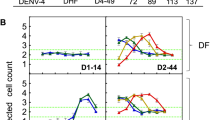Abstract
To date, the phatophysiology of hemorrhagic dengue is still unknown and hypotheses which aim to explain the unfortunate cases of the disease (hemorrhagic fever/shock syndrome) are based on epidemiological data and favor the notion of the participation of heterotypic non-neutralizing antibodies during the course of secondary infection (immunologic status of the host). However, cases of hemorrhagic dengue have been reported during the course of primary infections. We propose that the dengue virus, specifically the envelope glycoprotein can participate directly in the installation of the hemorrhagic phenomenon by means of the binding and activation of plasminogen (PLG) as condition previous to the development of the fibrinolytic process. Based on this hypothesis, we evaluated the biological activity of some viral isolates proceeding from hemorrhagic and from dengue fever cases in an in vitro model of fibrinolysis. Dengue isolates were capable of activating PLG. The plasmin generated specifically degraded the fibrin/fibrinogen molecule. This catalytic process can be prevented by the presence of the specific plasmin inhibitor, α-2-antiplasmin, for virus isolates from dengue fever, but not for isolates associated with dengue hemorrhagic disease, favoring the exacerbation of the fibrinolytic activity. This new approach allows us to suggest the importance of viral factors in the dengue hemorrhagic fever.
Similar content being viewed by others
References
Westaway E.G., Adv Virol Res 33, 45–90, 1987.
Gubler D.J., Clin Microbiol Rev 11, 480–496, 1998.
Henchal E.A. and Putnak R., Clin Microbiol Rev 3, 376–396, 1990.
Halstead S.B., J Infect Dis 140, 527–533, 1979.
Halstead S.B. and O'Rourke E.J., J Exp Med 146, 210–217, 1977.
Barnes W.J.S. and Rosen L., Am J Trop Med Hyg 23, 495–506, 1974.
Rosen L., Am J Trop Med Hyg 26, 337–343, 1977.
Gubler D.J., Reed D., Rosen L., and Hitchcock JC. Jr., Am J Trop Med Hyg 27, 581–589, 1978.
Bielefeldt-Ohumann H., Trends Microbiol 5, 409–413, 1997.
Lanciotti R.S., Calisher C.H., Gubler D.J., Chang G.J., and Vorndam A.V., J Clin Microbiol 30, 545–551, 1992.
Laemmli UK., Nature 227, 680–685, 1970.
Yuill T.M., Sukhavachan P., Nisalak A., and Russell P.K., Am J Trop Med Hyg 14, 441–448, 1968.
Vries C., Veerman H., and Pannekoek H., J Biol Chem 264, 12604–12610, 1989.
Towbin H., Stachelin T., and Gordin J., Proceedings of the National Academy Sciences USA 76, 4350–4354, 1979.
Sugiyama N., Sasaki T., Iwamoto M., and Abilo Y., Biochim Biophys Acta 952, 1–7, 1988.
Hays W.L., Statistics, 4th. ed. New York: CBS College Publishing, 1988.
Smith J.H., Morris J.P., Chibber B.A., and Castellino F.J., Thromb Res 234, 499–506, 1984.
Strichaikul T., Punyagupta S., Nitiyanant P., and Alkarawong K., Southeast, Am J Trop Med Hyg 6, 106–114, 1975.
Plow E.F., Ferez J., and Miles L.A., Thromb Haemostasis 66, 32–36, 1991.
Boyle M. and Lottenberg R., Thromb Haemostasis 77, 1–10, 1997.
Gubler D.J. and Trent D.W., Infect Agent Dis 2, 383–393, 1994.
Halstead S.B., Science 239, 476–481, 1988.
Halstead S.B., J Infect Dis 11,(Suppl. 4) S830–S839, 1989.
Scott R.M., Nimmannitya S., Bancroft W.H., and Mansuwan P., Am J Trop Med Hyg 25, 866–874, 1976.
Domingo E., Diez J., Martínez M.A., Hernandez J., Holguin A., Borrego B., and Mateu M.G., J Gen Virol 74, 2039–2045, 1993.
Mangada M.N.M. and Igarashi A., Virology 244, 458–466, 1998.
Sánchez I.J. and Ruiz B.H., J Gen Virol 77, 2541–2545, 1996.
Almagro D., González I., Cruz Y., and Castañeda M., Revista Cubana de Medicina Tropical 36, 352–39, 1984.
Plow E.F., Herren T., Redlitz A., Miles L.A., and Hoover-Plow J.L., FASEB J 9, 939–945, 1995.
Wang X., Lin X., Loy J.A., Tang J., and Zhang X.C., Science 281, 1662–1665, 1998.
Rey F.A., Heinz F.X., Mandl C., Kunz C., and Harrison S.C., Nature 375, 291–298, 1995.
Chen Y., Maguire T., Hileman R.E., Fromm J.R., Esko J.D., Linhardt R.J., and Marks R.M., Nat Med 3, 866–871, 1997.
Putnak J.R., Kanesa-Thasan N., and Innis B.L., Nat Med 3, 828–829, 1997.
Author information
Authors and Affiliations
Rights and permissions
About this article
Cite this article
Monroy, V., Ruiz, B.H. Participation of the Dengue Virus in the Fibrinolytic Process. Virus Genes 21, 197–208 (2000). https://doi.org/10.1023/A:1008191530962
Issue Date:
DOI: https://doi.org/10.1023/A:1008191530962




